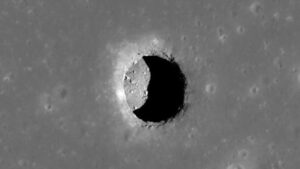Yesterday at 105˚F in my central Texas city, I watched a haggard man remove an irrigation valve cover in a parking lot median, open the valve inside, and stand directly in the resulting blast.
He’s not the only one getting creative to beat this summer’s exceptional heat. But where he looked underground for relief, someone else is looking the other direction — by a very long way.
One University of Hawaiʻi astronomer thinks we can cool Earth by tying a giant umbrella to an asteroid, then stationing it between the earth and the sun. A peer-reviewed paper detailing the idea, called “Solar radiation management with a tethered sun shield,” appeared yesterday in the journal Proceedings of the National Academy of Sciences (PNAS).
There’s no indication that work on this counterweighted solar shield is underway, but if an effort did succeed, it could “mitigate climate change within decades,” according to the University’s UH News.
It’s pretty conceptual. Take it from study author Istvan Szapudi.
Weight is the main obstacle
“In Hawaiʻi, many use an umbrella to block the sunlight as they walk about during the day. I was thinking, could we do the same for Earth and thereby mitigate the impending catastrophe of climate change?” Szapudi told the University.
For a structure, the paper suggests that multiple shields “could open up in a petal configuration” once in orbit. Connected to counterweights, “a slow opening allows the gradual filling of the counterweight with lunar dust or asteroid material.”
Feasible or not, it seems like a cool idea. As the paper points out, plenty of scientists have proposed cooling the planet with shade structures in space before. Realizing it’s cooler in the shade doesn’t take a — ready for this one? — rocket scientist.
But weight is a fatal flaw. To deflect away 1.7% of the sun’s energy, we’d need a shield that weighed about 32,000 tonnes, Szapudi’s team calculated. Today’s strongest rocket systems can only deposit about 45 tonnes into low orbit.
Not only that, the structures would need to stay at a steady weight and the proposed “tethers” would need to remain attached to keep them all in orbit.
“If multiple tethers hold the shield, breaking one or two would not create an accident,” the paper postulates. But it “has enough weight to wreak havoc if it accidentally crashes on Earth.”
It also notes that sourcing cables strong enough to do the job is a major obstacle.
With a glimmer of intuition, though, the proposal does at least indicate a solution to the problem at hand. If you need thing A in place B but it takes too much work to bring thing A with you on your way there — then use what you find when you arrive.
Until then, I know just what parking lot median to visit for a cool-down right here on Earth.






